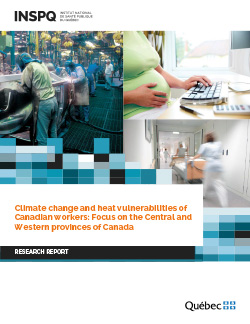Climate change and heat vulnerabilities of Canadian workers: Focus on the Central and Western provinces of Canada
This study on the relationship between summer temperatures and worker health in five Canadian provinces has produced new knowledge that can guide decision-makers and prevention stakeholders. Drawing on workers’ compensation claims data from Quebec, Ontario, Manitoba, Saskatchewan and Alberta, as well as meteorological data, the study revealed that:
- For every 1°C increase in the daily maximum summer temperature for the 2001-2016 period, there was a 28% to 51% increase in the daily number of accepted heat illness claims (e.g. edema, syncope, exhaustion, sunstroke/heatstroke), depending on the province and the heat exposure indicator used; applied to the province of Quebec, a 34% increase (model based on Tmax) represents seven additional accepted heat illness claims over the five summer months of each year of the 2001-2016 period.
- No sex- or age-based disparities were observed in relation to the heat illness risk examined. In Quebec and Alberta, where information on industries was analyzed, no difference was found between industries that operate mainly indoors and those that operate mainly outdoors;
- For traumatic injuries (e.g. fractures, cuts, burns), each 1°C increase in daily summer temperature was associated with a 0.2% to 0.6% increase in the daily number of accepted claims during this period; this increase, though it may appear small, is important because of the large number of workers concerned. Applied to the province of Quebec, a 0.2% increase represents approximately 64 additional traumatic injury claims accepted per year during the 2001-2016 summer period.
- The risk of traumatic injury per 1°C increase in temperature is higher for men, younger workers (15–24 years) and, in the case of Quebec and Alberta, where information on industries was analyzed, for individuals working in industries that operate primarily outdoors.
This is the first study to provide projections for the daily number of heat illness claims that could be accepted in workers (e.g. edema, syncope, exhaustion, sunstroke/heatstroke) by 2050, taking into account expected climate warming:
- It is estimated that the daily number of heat illness claims will rise by a worrying 73% to 113% under an optimistic greenhouse gas emissions scenario (RCP4.5) and by 110% to 165% under a pessimistic scenario (RCP8.5), depending on the province and the heat exposure indicator used;
- Applied to the province of Quebec, the number of accepted heat illness claims per year during the summer period would increase from 21 in the reference period to 39 by 2050 under an optimistic scenario and to 47 under a pessimistic scenario (models based on Tmax).
Our results highlight the need to maintain and strengthen preventive efforts among workers as well as workplace adaptation efforts.
- The study results are of great importance in terms of prevention, as they would enable more targeted awareness and engagement efforts aimed at legislators, the research community and key prevention stakeholders.
- Since heat illness projections are based on current workplace preventive programs and strategies and since these health problems are often preventable, there would no doubt be much to gain from taking action.
Legal Deposit


